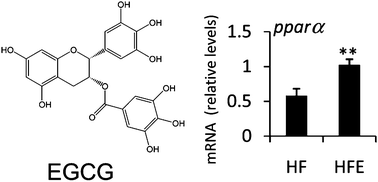(−)-Epigallocatechin-3-gallate increases the expression of genes related to fat oxidation in the skeletal muscle of high fat-fed mice
Abstract
(−)-Epigallocatechin-3-gallate (EGCG), the major

* Corresponding authors
a
Department of Food Science, The Pennsylvania State University, 332 Food Science Building, University Park, PA, USA
E-mail:
jdl134@psu.edu
Fax: (+814)863-6132
b Department of Veterinary and Biomedical Science, The Pennsylvania State University, University Park, PA, USA
(−)-Epigallocatechin-3-gallate (EGCG), the major

 Please wait while we load your content...
Something went wrong. Try again?
Please wait while we load your content...
Something went wrong. Try again?
S. Sae-tan, K. A. Grove, M. J. Kennett and J. D. Lambert, Food Funct., 2011, 2, 111 DOI: 10.1039/C0FO00155D
To request permission to reproduce material from this article, please go to the Copyright Clearance Center request page.
If you are an author contributing to an RSC publication, you do not need to request permission provided correct acknowledgement is given.
If you are the author of this article, you do not need to request permission to reproduce figures and diagrams provided correct acknowledgement is given. If you want to reproduce the whole article in a third-party publication (excluding your thesis/dissertation for which permission is not required) please go to the Copyright Clearance Center request page.
Read more about how to correctly acknowledge RSC content.
 Fetching data from CrossRef.
Fetching data from CrossRef.
This may take some time to load.
Loading related content
